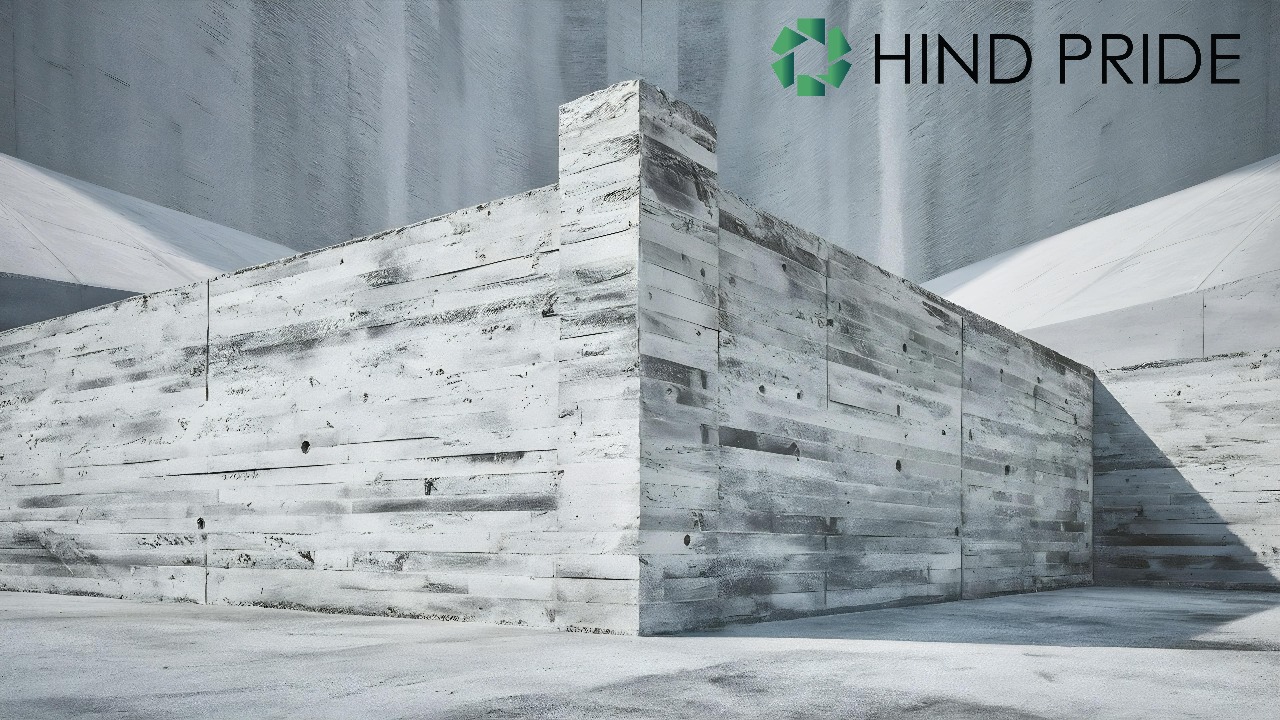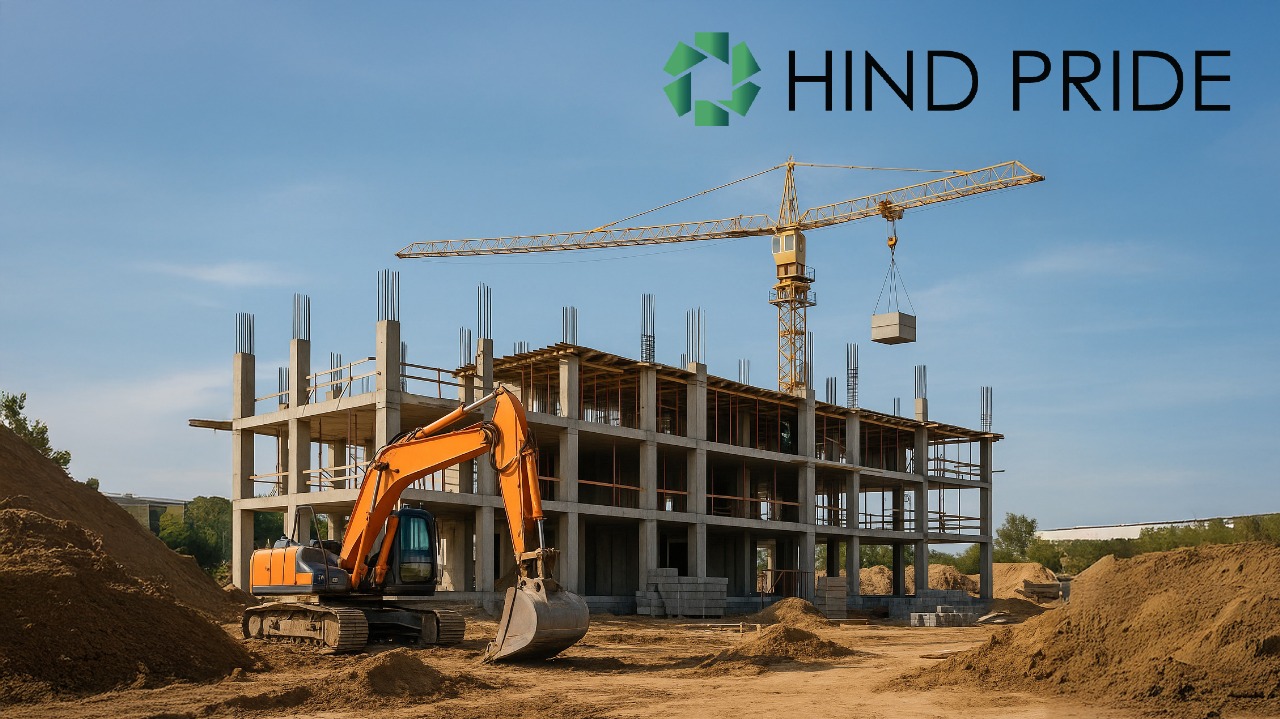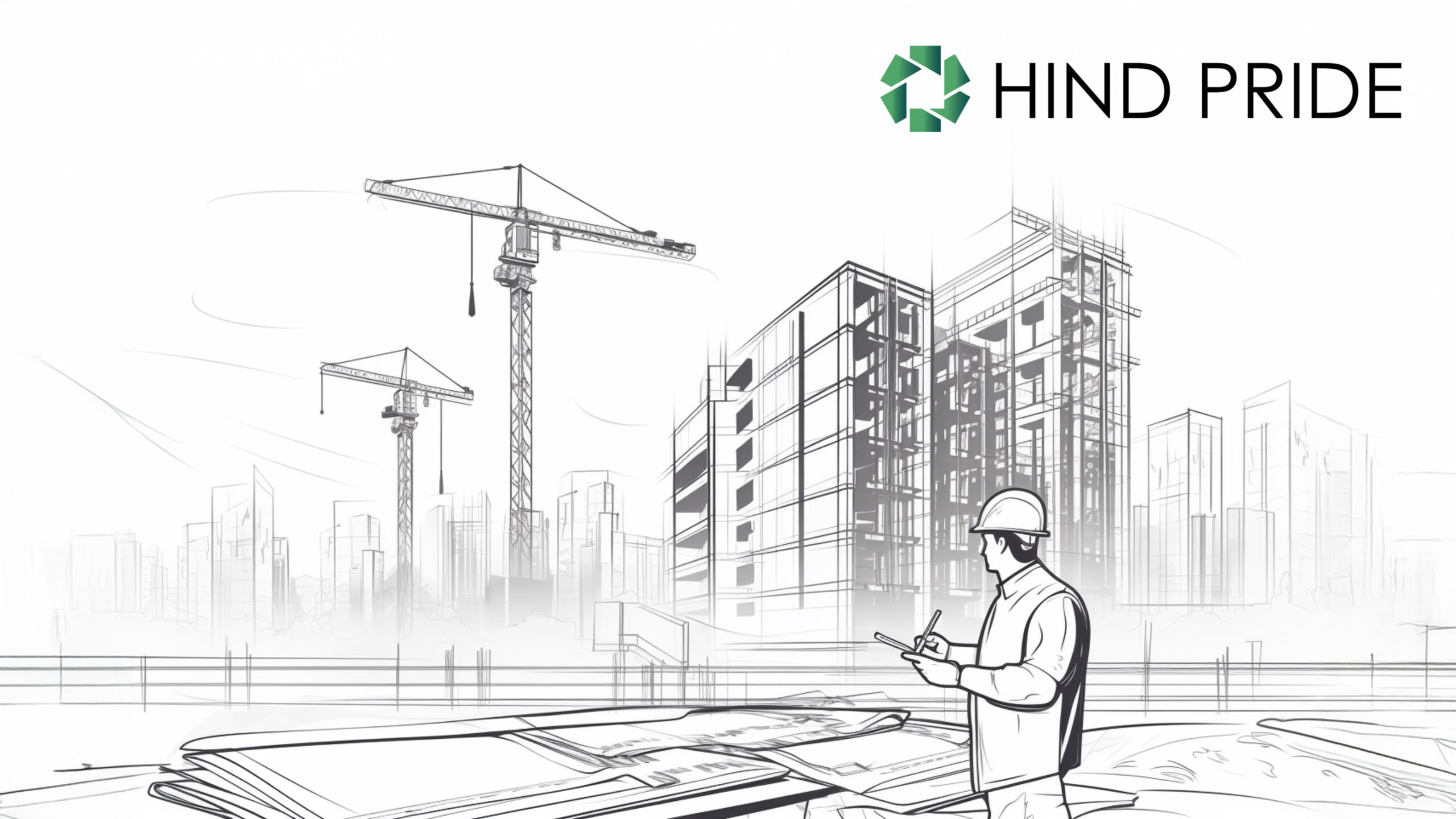

Table of Contents
TogglePicture this.
It’s 7 a.m. at a Hindpride project in Gurugram. The site is quiet—no clatter of brick stacks, no cement dust clouding the air. By lunchtime, a brand-new 200-meter boundary wall stands complete. Straight. Polished. Zero plaster.
That’s the power of RCC panels—the reinforced cement concrete innovation changing how India builds.
Developers across Delhi, Noida and Faridabad have already begun replacing brickwork with these precision-made panels. They build five times faster, last twice as long and create almost no waste.
For Hindpride, this isn’t just a new material; it’s a new mindset: building that balances speed with sustainability.
RCC panels—short for Reinforced Cement Concrete panels—are factory-made slabs of concrete strengthened with steel mesh or bars. Once they’re cured and tested for strength, they’re transported to the site and assembled like a modular system.
Unlike brick walls that depend on on-site labour and weather, RCC panels arrive ready to install. That means predictable quality, cleaner sites and dramatically shorter timelines.
They are used in everything from boundary walls and industrial sheds to sound barriers, retaining walls and modern farmhouses.
At their core, RCC panels combine the compressive strength of concrete and the tensile resilience of steel. This combination has powered skyscrapers for decades and is now being applied to faster, cleaner, and more modular construction.
RCC panels adhere to the same structural principles as conventional reinforced concrete, but with advanced fabrication and testing to ensure optimal performance, longevity, and load-bearing capacity.
Every RCC panel starts on a computer. Engineers design according to, calculating thickness, reinforcement, bending moments, and cover depth.
The panels are modelled to withstand both static and dynamic loads — including seismic shocks typical of regions like the Delhi-NCR area.
Step 2: Mould Preparation
Reusable steel or FRP moulds are precision-fitted with reinforcement cages. Grooves, conduits, or lifting hooks are positioned exactly as per design drawings.
Step 3: Casting & Compaction
High-grade concrete (M25–M40) is poured into moulds under vibration to remove air pockets and ensure density.
Step 4: Controlled Curing
Panels are steam-cured for 12–24 hours to achieve up to 80% design strength in a single day — compared to 7–14 days for traditional methods.
Every panel undergoes compressive and flexural testing before dispatch. Finishes can include smooth, textured, or decorative surfaces.
Step 6: Transport & Installation
Panels are trucked to the site and installed using cranes, with dowel connections or groove joints for precise fitment.
Speed That Saves Projects
Time is the new profit margin.
A boundary wall that once took 20 days with brick masonry now finishes in just 48 hours using RCC panels.
For commercial and industrial projects, that’s not just faster — it’s more predictable, less risky, and dramatically cheaper in overheads.
Quality That Doesn’t Depend on Labour or Weather
Because panels are made in factories, the quality is machine-consistent — no uneven plaster, no hollow joints, and no curing issues.
Whether it’s monsoon or peak summer, production continues unaffected.
Strength and Durability You Can Measure
With steel reinforcement and concrete grades up to M40, these panels can withstand wind speeds of 200 km/h, seismic loads, and years of environmental exposure.
A typical RCC panel has a life expectancy of 50 years or more, which is double that of brick masonry.
Cost Control Through Efficiency
Yes, RCC panels may cost ₹ 80–120 per sq ft upfront versus ₹ 180–200 for brick masonry, but consider the savings:
Traditional construction wastes 10–15% of material on-site. Precast RCC production reduces waste by over 60%.
With controlled batching, no onsite curing, and reusable moulds, RCC panels align perfectly with GRAP and IGBC sustainability norms.
Safety for People and Projects
With fewer onsite workers, less scaffolding, and reduced manual mixing, RCC panels significantly lower the construction risk.
Panels are also non-combustible and provide 4-hour fire resistance, which is essential for industrial zones.
Precision = Fewer Delays
With prefabrication, the entire process becomes data-driven. You get what you design — every time.
No guesswork, no rework. Just results.
Criteria | RCC Panels | Brick Masonry |
Speed | 5× faster | Slow, labour-heavy |
Durability | 50+ years | 20–25 years |
Average Cost (NCR) | ₹ 80–120/sq ft | ₹ 180–200/sq ft |
Maintenance | Minimal | High |
Labor Need | Low | High |
Sustainability | High | Low |
1. Boundary Walls
From housing societies to logistics parks, RCC boundary walls are becoming the default choice — strong, sleek, and near-maintenance-free.
2. Commercial Buildings
Panels are being used for façades, internal partitions, and load-bearing shells.
3. Farmhouses & Modular Villas
At Hindpride, we utilise RCC panels in farmhouse construction, offering thermal comfort, energy savings, and a quick installation process.
4. Industrial & Infrastructure Projects
Sound barriers, retaining walls, culverts, and even metro stations use precast RCC panel systems.
Technical Insights You Shouldn’t Ignore
Panel Thickness: 50–200 mm
Concrete Grade: M25–M40
Steel Reinforcement: 8–10 mm Fe500 bars
Joint Sealants: PU-based or epoxy
Code Reference: IS 15916:2010 – Precast Concrete Building Systems
Limitation | Solution |
Higher Initial Setup Cost | Offset by faster completion and lower lifecycle cost |
Transport Challenges | Use modular panels (<3 m width) |
Joint Leakage Risk | Apply professional sealants |
Limited Flexibility | Plan layout precisely using BIM |
Design Complexity | Partner with certified structural consultants |
The next wave of RCC panels will be brighter, lighter, and greener.
The NCR region faces unique challenges:
RCC panels address all of these at once.
No on-site curing, no pollution, and minimal waste.
For city projects, it’s the difference between delays and delivery.
At Hindpride, we don’t just use RCC panels — we engineer around them.
Our process includes:
Each project becomes faster, cleaner, and better — aligning with both client timelines and environmental goals.
“Our Gurugram commercial site finished its boundary wall in 72 hours flat.
The precision was remarkable — no cracks, no rework.”
— Project Engineer, Hindpride Partner (2025)
“RCC panels have completely changed our approach. The finish and speed are unmatched.”
— Architect, Noida Sector 135
India’s construction sector is responsible for approximately 22% of the country’s total emissions.
Adopting RCC panels could cut that by up to 35%, thanks to:
RCC panels are the green choice — and the smart one.
1. What are RCC panels in construction?
RCC panels are Reinforced Cement Concrete panels — factory-made precast concrete slabs reinforced with steel bars or mesh.
They are manufactured under controlled conditions, cured for strength, and installed directly on-site to form walls, partitions, or boundaries.
Unlike traditional brickwork, RCC panels require no curing, no plaster, and deliver long-lasting structural strength.
2. How are RCC panels different from brick walls?
RCC panels are pre-engineered and pre-cured, while brick walls are built manually on site.
A 100-meter brick wall might take 15–20 days to build, whereas the same wall made of RCC panels can be installed in just 2 days.
Panels are smoother, stronger, weather-resistant, and require almost zero maintenance over time.
3. Are RCC panels durable enough for long-term use?
Absolutely. RCC panels are designed as per and with proper installation and sealing, their average lifespan exceeds 50 years.
They resist corrosion, wind pressure, termites, and temperature variations better than brick or block structures.
4. How much do RCC panels cost in Delhi-NCR?
The average cost of RCC panels in Delhi-NCR ranges between ₹80–₹120 per sq. ft, depending on design, height, and thickness.
Brickwork, in comparison, costs around ₹180–₹200 per sq. ft once plaster and curing are added.
Despite a slightly higher initial setup, RCC panels save 30–40% in total lifecycle costs through reduced labor and faster completion.
5. Can RCC panels be used for all types of buildings?
Yes. RCC panels are versatile — they can be used for:
Boundary walls
Commercial and office façades
Modular homes and villas
Industrial enclosures
Retaining and sound barriers
They’re suitable for both load-bearing and non-load-bearing applications depending on design.
6. Are RCC panels environmentally friendly?
Yes — RCC panels are significantly more sustainable than brickwork.
They reduce site waste by 60%, eliminate the need for curing water, and use fly-ash or recycled aggregates in manufacturing.
They also align with GRAP and IGBC green building standards, making them ideal for Delhi-NCR’s pollution-sensitive construction zones.
7. What are the common challenges in using RCC panels?
Some challenges include higher initial setup cost, transportation limits for oversized panels, and sealing of joints.
However, with modular sizing (under 3 meters) and professional sealants, these issues are easily managed.
Hindpride partners only with BIS-certified RCC panel vendors to ensure flawless execution.
8. Why should I choose RCC panels for my next project?
If you value speed, strength, sustainability, and savings, RCC panels are the smarter choice.
They shorten project timelines, cut costs, improve quality, and help you meet environmental guidelines.
At Hindpride, we’ve used RCC panel systems across Delhi-NCR to deliver projects faster and greener — proving they’re not the future of construction, they’re the present.
If your construction timeline feels like a ticking clock, it’s time to shift gears.
RCC panels are not just another building material — they’re a revolution in speed, strength, and sustainability.
Whether you’re designing a commercial complex, an industrial warehouse, or a modern farmhouse in Delhi-NCR, Hindpride’s panel-based construction systems deliver results that brickwork simply can’t match.
With 50% shorter project cycles, 35% cost savings, and zero curing or pollution, you’re not just saving time — you’re building smarter for the planet and your bottom line.
🏗️ Here’s what you gain with Hindpride’s RCC panel expertise:
Factory-engineered precision with IS-code compliance
Sustainable sourcing aligned with GRAP and IGBC standards
Real-time execution monitoring and on-site quality control
Custom design integration for residential, commercial, or industrial projects
👉 Book your free project consultation now to see how RCC panels can transform your next build.
📞 Talk to our experts: hindpride
📍 Explore our ongoing projects in Delhi, Gurugram & Noida: hindpride
Hindpride — Building Beyond Boundaries. One RCC Panel at a Time.


